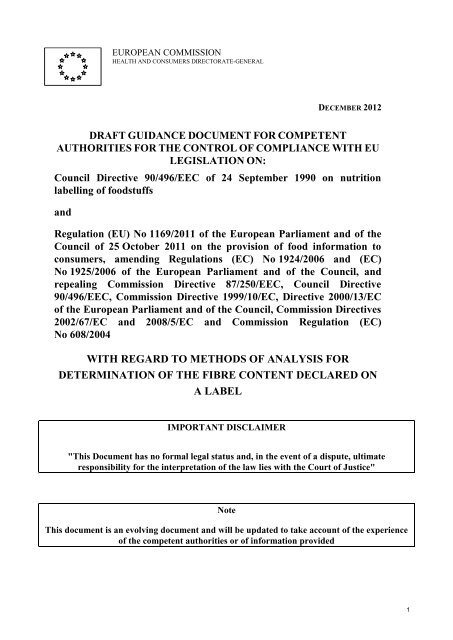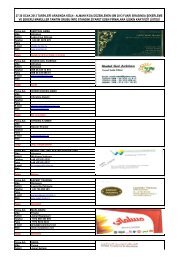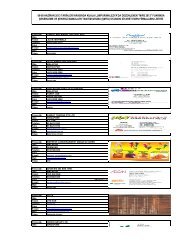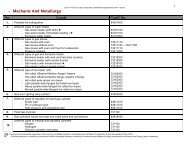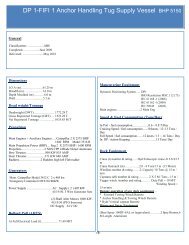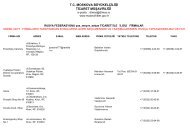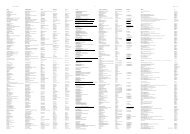DRAFT GUIDANCE DOCUMENT FOR COMPETENT AUTHORITIES ...
DRAFT GUIDANCE DOCUMENT FOR COMPETENT AUTHORITIES ...
DRAFT GUIDANCE DOCUMENT FOR COMPETENT AUTHORITIES ...
You also want an ePaper? Increase the reach of your titles
YUMPU automatically turns print PDFs into web optimized ePapers that Google loves.
EUROPEAN COMMISSIONHEALTH AND CONSUMERS DIRECTORATE-GENERALDECEMBER 2012<strong>DRAFT</strong> <strong>GUIDANCE</strong> <strong>DOCUMENT</strong> <strong>FOR</strong> <strong>COMPETENT</strong><strong>AUTHORITIES</strong> <strong>FOR</strong> THE CONTROL OF COMPLIANCE WITH EULEGISLATION ON:Council Directive 90/496/EEC of 24 September 1990 on nutritionlabelling of foodstuffsandRegulation (EU) No 1169/2011 of the European Parliament and of theCouncil of 25 October 2011 on the provision of food information toconsumers, amending Regulations (EC) No 1924/2006 and (EC)No 1925/2006 of the European Parliament and of the Council, andrepealing Commission Directive 87/250/EEC, Council Directive90/496/EEC, Commission Directive 1999/10/EC, Directive 2000/13/ECof the European Parliament and of the Council, Commission Directives2002/67/EC and 2008/5/EC and Commission Regulation (EC)No 608/2004WITH REGARD TO METHODS OF ANALYSIS <strong>FOR</strong>DETERMINATION OF THE FIBRE CONTENT DECLARED ONA LABELIMPORTANT DISCLAIMER"This Document has no formal legal status and, in the event of a dispute, ultimateresponsibility for the interpretation of the law lies with the Court of Justice"NoteThis document is an evolving document and will be updated to take account of the experienceof the competent authorities or of information provided1
1. INTRODUCTION1.1 Scope of this guidanceThis document has been prepared to provide guidance to Member States' control authorities andfood business operators on the methods of analysis for determination of the fibre content declaredon a label with respect to the nutrition labelling or declaration.1.2 Definition of fibreThe term 'fibre' was defined by Commission Directive 2008/100/EC of 28 October 2008 1 amendingCouncil Directive 90/496/EEC 2 on nutrition labelling for foodstuffs as regards recommended dailyallowances, energy conversion factors and definitions as:'fibre' means carbohydrate polymers with three or more monomeric units, which are neitherdigested nor absorbed in the human small intestine and belong to the following categories:- edible carbohydrate polymers naturally occurring in the food as consumed;- edible carbohydrate polymers which have been obtained from food raw material by physical,enzymatic or chemical means and which have a beneficial physiological effect demonstrated bygenerally accepted scientific evidence;- edible synthetic carbohydrate polymers which have a beneficial physiological effectdemonstrated by generally accepted scientific evidence."This definition has been included in Annex 1 of Regulation 1169/2011/EU 3 on the provision of foodinformation to consumers. Regulation 1169/2011/EU will apply from 13 December 2014 and at thesame time Directive 90/496/EEC will be repealed.Furthermore, Commission Directive 2008/100/EC specifies additional information in the followingrecitals concerning the definition of fibre:"(5) Fibre has been traditionally consumed as plant material and has one or more beneficialphysiological effects such as: decrease intestinal transit time, increase stool bulk, is fermentableby colonic microflora, reduce blood total cholesterol, reduce blood LDL cholesterol levels,reduce post-prandial blood glucose, or reduce blood insulin levels. Recent scientific evidence hasshown that similar beneficial physiological effects may be obtained from other carbohydratepolymers that are not digestible and not naturally occurring in the food as consumed. Therefore itis appropriate that the definition of fibre should include carbohydrate polymers with one or morebeneficial physiological effects.(6) The carbohydrate polymers of plant origin that meet the definition of fibre may be closelyassociated in the plant with lignin or other non-carbohydrate components such as phenoliccompounds, waxes, saponins, phytates, cutin, phytosterols. These substances when closelyassociated with carbohydrate polymers of plant origin and extracted with the carbohydratepolymers for analysis of fibre may be considered as fibre. However, when separated from thecarbohydrate polymers and added to a food these substances should not be considered as fibre."123OJ L 285, 29.10.2008, p. 9–12OJ L 276, 6.10.1990, p. 40–44OJ L 304, 22.11.2011, p. 18-632
Table 1: Methods of analysis for fibreSTANDARD PROVISIONS METHOD PRINCIPLE TYPE 5Section1: General methods that measure both the higher (monomeric units >9) and the lower molecular weight fraction(monomeric units ≤9)All foods 6 Method applicable fordetermining the content of fibresof higher and lower molecularweight, in food where resistantstarches are not presentAOAC 2001.03AACC Intl 32-41.01 (2002)All foods 6Method applicable fordetermining the content of fibresof higher and lower molecularweight. The method is applicablein food that may, or may not,contain resistant starches.AOAC 2009.01AACC Intl 32-45.01 (2009)Enzymaticgravimetry andLiquid chromatographyEnzymaticgravimtry HighPressure LiquidchromatographyTypeITypeI5Type of methods as referred to in Codex Alimentarius Commission: Procedural Manual, 20 th edition, page 63.ftp://ftp.fao.org/codex/Publications/ProcManuals/Manual_20e.pdf6 Users should consult the description of each method for the food matrices that were the subject of interlaboratory study in the Official methods of Analysis of AOAC International4
Section 2: General methods that do not measure the lower molecular weight fraction (i.e. monomeric units ≤9)All foods 6 Method applicable forAOAC 985.29determining fibres that do not AACC Intl 32-05.01 (1991,1999)include the lower molecularweight fraction 7All foods 6All foods 6All foods 6All foods 6All foods 6Method applicable forAOAC 991.43determining fibres that do notinclude the lower molecularweight fraction and also includesdetermination for soluble andinsoluble fibres 7AACC Intl 32-07.01 (1999,1991)NMKL 129, 2003EnzymaticgravimetricEnzymaticgravimetricMethod applicable fordetermining fibres that do notinclude the lower molecularweight fraction in foods and foodproducts containing morethan10% fibre and less than 2%starch (e.g. fruits) 7 AOAC 993.21 Gravimetry TypeIMethod applicable forAOAC 994.13determining fibres that do notinclude the lower molecularweight fraction. Provides sugarresidue composition of fibrepolysaccharides, as well as contentof Klason lignin 7AACC Intl 32-25.01 (1999,1994)NMKL 162, 1998Enzymatic gaschromatographycolourimetrygravimetryInsoluble fibres in food and food AOAC 991.42 (specific for insoluble fibre)Enzymaticproducts 7AACC Intl32-20.01 (1999,1982) NMKLgravimetricSoluble fibres in food and food AOAC 993.19 (specific for soluble fibre) Enzymaticproducts 7 gravimetricTypeITypeITypeITypeITypeI7 Quantitation lost for inulin, resistant starch, polydextrose and resistant maltodextrins. Refer to specific methods.5
Section 3: Methods that measure individual specific components (monomeric units: the whole range for each type of components is covered)All foods 6 (13)(14)Beta-D-Glucans AOAC 995.16AACC Intl 32-23.01 (1999,1995)Enzymatic TypeIIAll foods 6 Fructans (oligofructoses, inulin,hydrolysed inulin, polyfructoses,fructooligosaccharides)(applicable to added fructans)AOAC 997.08AACC Intl 32-31.01 (2001)Enzymatic &HPAEC-PADTypeIIAll foods 6Fructans (oligofructoses, inulin,hydrolysed inulin, polyfructoses,fructooligosaccharides)(not applicable to highlydepolymerised fructans)AOAC 999.03AACC Intl 32-32.01 (2001)All foods 6 Polydextrose AOAC 2000.11AACC Intl 32-28.01 (2001)All foods 6 Trans-galacto-oligo saccharides AOAC 2001.02AACC Intl 32-33.01 (2001)All foods 6 Resistant starch (recommended AOAC 2002.02for RS3AACC Intl 32-40.01 (2002)Section 4: Other methods that have not been subjected to interlaboratory evaluationYeast cell Insoluble glucans and mannans ofwall yeast cell wall (for yeast cell wallAll foodsAll foodsonly)Fructo-oligosaccharides(monomeric units
List of Abbreviations:AACC Intl.AOAC:HPAEC-PAD:RS3:American Association of Cereal Chemists International(http://www.aaccnet.org/about/)Association of Analytical Communities (http://www.aoac.org/)High Performance Anion Exchange Chromatography with PulsedAmperometric DetectionResistant starch that is formed when starch-containing foods are cooked andcooled7


